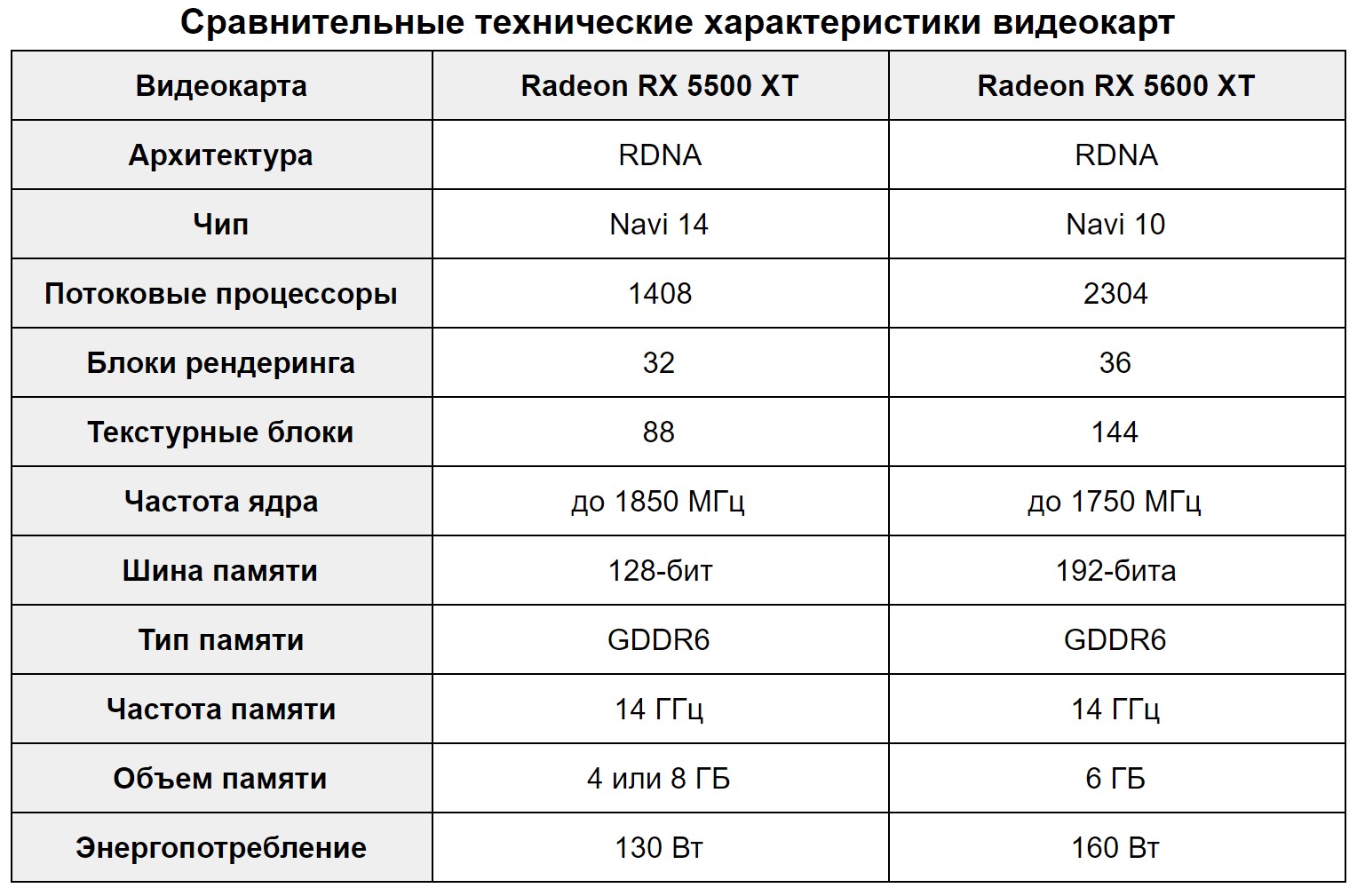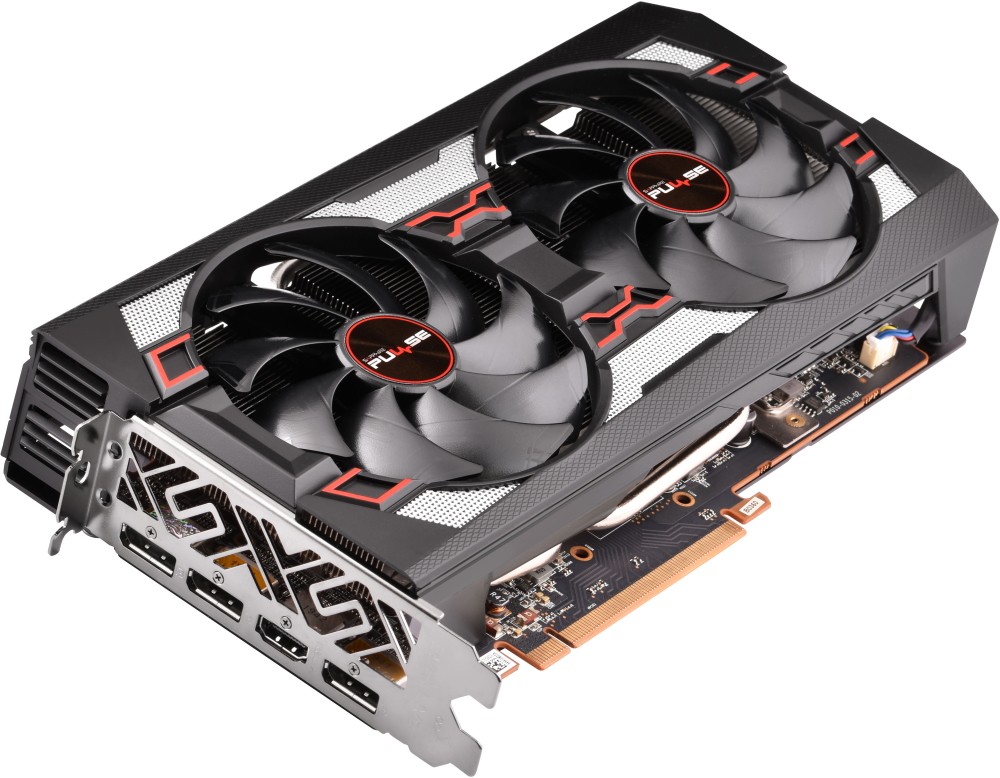Radeon RX 5500XT vs 5600XT (8GB vs 6GB) — comparative review and test in games
We independently test the products and technologies that we recommend.

Architectural Features
The junior AMD Radeon RX 5500 XT graphics card is built on the Navi 14 chip with 1408 RDNA architecture stream processors. These are unified graphics microkernels responsible for rendering most 3D objects in games, as well as applying post-processing effects (shadows, highlights, anti-aliasing). In addition to them, Navi 14 includes 32 render units (ROP) and 88 texture units (TMU). The fill rate depends on them, that is, the speed at which the screen is filled with pixels and textures.
Following it in the lineup, the Radeon RX 5600 XT is based on the Navi 10 core. The number of stream processors, render units and texture units is 2304, 36 and 144 pieces, respectively. As you can see, the advantage in the number of microcores is already one and a half times, albeit at a lower core frequency (1750 versus 1850 MHz for the RX 5500 XT). But is this enough to cover the smaller amount of video memory?
 |
Almost all "graphic" games of recent years, especially at screen resolutions higher than FullHD, that is, 2K and 4K, consume from 7 to 9 GB of video memory. If the native memory graphics card has less than the required volume, then the missing part gets at the expense of the system-wide RAM. That's just it's slow DDR4 bandwidth (BWB) at best: 2 x 64-bit x 3200 MHz = 50 GB/s. And if a PC has only one bar of RAM, and even with a low frequency of 2400 MHz, then the memory bandwidth will be only 20 GB / s.
For comparison, even the younger Radeon RX 5500 XT with a relatively narrow 128-bit memory bus has a GDDR6 14 GHz bandwidth of as much as 225 GB / s, that is, five times more than DDR4. And the 192-bit RX 5600 XT shows an even higher memory bandwidth — 336 GB / s. At the same time, she has only 6 GB of native fast video memory, that is, with a high probability she will have to get another 1 – 3 GB from a slow RAM.
 |
In the case of the RX 5500 XT, the buyer is offered two options to choose from: a 4 GB version for owners of FullHD monitors and an 8 GB version for QuadHD displays (for an UltraHD resolution, the RX 5500 XT is generally rather weak). Whereas the RX 5600 XT is devoid of any variability. By the way, AMD first announced that the memory frequency of the RX 5600 XT would be only 12 GHz, so as not to create a competitor for the older RX 5700, but then, fearing pressure from the GeForce RTX 2060 Super, increased the frequency to 14 GHz by updating the BIOS firmware.
And now let's move from theory to practice using the products of Sapphire Technology, the world's largest manufacturer of video cards based on AMD Radeon chips, as an example.

Sapphire Nitro+ RX 5500 XT 8G GDDR6 SE is the junior representative of the 5000-series AMD Radeon graphics cards (at least until the release of the RX 5300), but with the top-end Sapphire Nitro+ SE cooling system. In terms of gaming performance, it approximately corresponds to the previous Sapphire Radeon RX 570 11266-66-20G , but in terms of energy efficiency it significantly exceeds it — less than 130 W versus more than 150. All thanks to the progressive 7-nanometer process technology.
In addition to the fast PCI-E 4.0 x8 interface, the RX 5500 XT also supports a couple of new AMD technologies: Radeon Image Sharpening and Radeon Anti-Lag. The former sharpens small image details without dropping FPS, and the latter reduces input lag by cutting off unnecessary frame requests. And of course, it supports the latest graphics APIs — Vulkan and DirectX 12.1.
The RX 5500 XT is useful not only in games, but also in professional work applications. So, OpenCL technology speeds up photo editing, and Radeon Media Encoder (RME) — video editing. Moreover, all modern video codecs are supported: H.264 AVC, H.265 HEVC and WebM VP9, including those with extended HDR 10-bit colour range. With RME, you can also stream to Twitch, YouTube or Mixer without loading your CPU.
The Sapphire Nitro+ RX 5500 XT 8G GDDR6 SE cooling system consists of an array of aluminium fins connected by two nickel-plated copper tubes, two 9.5 cm fans and a backplate. Moreover, heat is removed not only from the graphics chip, but also from memory chips and mosfets of the graphics card power subsystem. And the RGB-decorated fans turn off completely when the graphics card is idle (below 50°C) to minimize noise.
All in all, the Sapphire Nitro+ RX 5500 XT 8G GDDR6 SE is a quiet, cool and moderately priced graphics card with a solid amount of “growth” video memory that will appeal to photographers, video editors and, of course, gamers alike. The performance of the RX 5500 XT is enough for high graphics settings even in the latest AAA games at a screen resolution of 1920x1080 pixels, or for medium settings at 2560x1440. By the way, an even more economical 4-gig version is available for sale Sapphire Radeon RX 5500 XT PULSE 4G .

| Luckylink.kiev.ua | 7 150 ₴ | To Store |
| Berloga.kh.ua | 8 600 ₴ | To Store |
| Rozetka.ua | 7 865 ₴ | To Store |
| Berloga.kh.ua | 8 950 ₴ | To Store |
Sapphire Pulse RX 5600 XT 6G GDDR6 is one of the most affordable modifications of the Radeon RX 5600 XT graphics card in east european retail. Equipped with a solid cooling system without frills in the form of backlighting. Built on the Navi 10 chip, which is also used in Sapphire RX 5700 PULSE with higher frequencies.
The amount of video memory in the RX 5600 XT is less than in the RX 5500 XT (6 vs. 8 GB), but this did not become a bottleneck, because the memory bus has been increased to 192-bit, and the connection interface has been expanded to 16 PCI-E lanes. Simply put, it doesn't matter which motherboard, with a PCI-E 3.0 or 4.0 slot, connect the RX 5600 XT. In both cases, it will give out one hundred percent of its performance.
In addition, Sapphire was the first among all graphics card manufacturers to update its Radeon RX 5600 XT with a new BIOS firmware with higher frequencies. So, the core frequency has increased by about a hundred megahertz, and the memory frequency has grown by as much as two gigahertz. This allowed the RX 5600 XT to come close to the performance level of the more expensive RX 5700.
Despite the discreet appearance, the two and a half-slot Sapphire Pulse cooling system is in no way inferior in efficiency to more expensive and beautiful counterparts. A pair of thick tubes channel the 160W of heat generated by the graphics chip to separate fins, from which it is dissipated by two large fans with Quick Connect dust removal technology. When the graphics card is idle, the propellers stop completely so as not to collect excess dust. There was also a place for a protective backplate.
As a result, Sapphire Pulse RX 5600 XT 6G GDDR6 is one of the most profitable mid-range graphics cards in terms of price and performance. Supports the latest AMD Radeon features: Image Sharpening, Anti-Lag and Media Encoder. It is the optimal solution for games at ultra-settings with a screen resolution of 1920x1080 pixels, or for high ones at 2560x1440. For 4K it's still better to pay extra for Sapphire Radeon RX 5700 XT NITRO+ 11293-03-40G Price from 8 250 up to 9 625 ₴ with a fully functional version of the Navi 14 chip with 2506 microcores and a frequency of 1900 MHz.
Test results
 |
findings
Gaming tests showed that the younger Radeon RX 5500 XT lagged about 30 percent behind the mid-range RX 5600 XT. And this is with one and a half times fewer microkernels and approximately the same difference in price. That is, a larger amount of video memory still partially leveled its lag, which is good news. However, this has always been the case with video cards: in order to get, conditionally, a twofold increase in FPS within one generation, you need to pay three times as much money. So if you want more microkernels, a higher core frequency, and more memory at the same time, buy the oldest Radeon RX 5700 XT at the moment, or wait for the imminent announcement of AMD's new flagship, codenamed Big Navi 20.
 |
Articles, reviews, useful tips
All materials


































